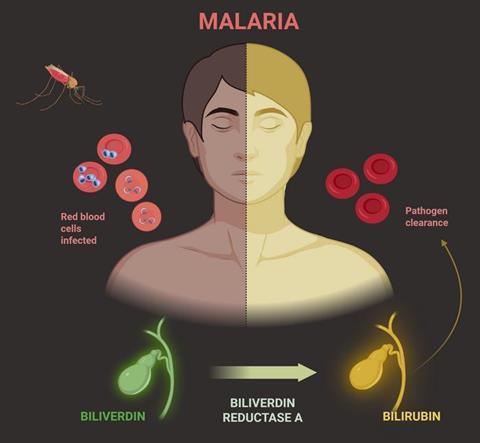New research suggests that a pigment that causes yellowing of the skin, or jaundice, may help protect people from the most severe consequences of malaria.

The report, which builds on a previous Johns Hopkins Medicine study on the protective role of bilirubin in the brain, is a collaboration between the labs of Miguel Soares, Ph.D., at the Gulbenkian Institute for Molecular Medicine in Portugal, and Bindu Paul, Ph.D., at Johns Hopkins Medicine.
READ MORE: How gut microbiota and isoflavones may alleviate geniposide hepatotoxicity
READ MORE: Researchers discover novel class of anti-malaria antibodies
The parasitic disease, transmitted by the bites of some mosquitoes, is estimated to affect more than 260 million people a year in tropical and subtropical areas, and kills around 600,000 people annually, according to the World Health Organization.
The new research findings suggest bilirubin may be a potential target of drugs that boost its production to prevent malaria’s most deadly or debilitating effects, says Paul, associate professor of pharmacology and molecular sciences at the Johns Hopkins University School of Medicine. Although bilirubin is one of the most commonly measured metabolites in the blood, Paul says its roles in the body are only beginning to be understood.
Additionally, doctoral student Ana Figueiredo, of the Soares lab, who helped spearhead the study, says these findings may indicate that bilirubin could help protect people against other infectious diseases.
A report on the findings was published June 12 in the journal Science.
Protective role
Soares connected with Paul after seeing her National Institutes of Health-funded research published in Cell Chemical Biology in 2019, which identified the important role bilirubin plays in protecting brain cells from damage from oxidative stress. Although prior research from the Soares lab had shown protective effects potentially related to bilirubin in people with malaria, Paul says it was unclear whether the pigment protected or worsened the disease.
The mouse model and methods used to measure bilirubin in the new study were initially developed by Paul’s lab for her 2019 study.
Jaundice, or yellowing of the skin, is a common presentation of malaria, says Paul, and anywhere from 2.5% to 50% of patients with malaria experience jaundice, according to two studies published in the New England Journal of Medicine and Clinical Infectious Disease.
Role of bilirubin
In a bid to pin down the role of bilirubin, the scientists collaborated with the lab of Florian Kurth at Charité Berlin, Germany, and Centre de Recherches Médicales de Lambaréné in Gabon to conduct an analysis of blood samples taken with permission from a volunteer group of 42 patients who were infected with malaria parasite P. falciparum, which causes the deadliest form of the condition, according to the World Health Organization.
Using techniques developed by Paul and further optimized at the Gulbenkian Institute to measure bilirubin and its precursor biliverdin, the scientists measured the amount of bilirubin not yet processed by the liver in blood samples with both asymptomatic and symptomatic malaria. They found that, on average, people with asymptomatic malaria had 10 times more unprocessed bilirubin in the blood as symptomatic people, and suspected that accumulation of the pigment may have helped protect them from malaria.
Next, the researchers exposed normal mice and mice genetically engineered to lack BVRA, a protein that helps produce bilirubin, to a form of malaria that infects rodents.
Rate of die-off
Using the same methods developed by Paul, the researchers analyzed the rate at which the malaria parasite died off in both bilirubin-lacking mice and in normal mice.
In normal mice, Soares says the concentration of unprocessed bilirubin in their systems increased significantly after they were infected with malaria, and all of the mice survived. In the mice lacking BVRA, the parasite spread vigorously, and all of the mice died.
The scientists at the Gulbenkian Institute then set out to test whether bilirubin could help BVRA-lacking mice overcome their infections, or whether it contributed to worsening symptoms. They gave bilirubin to malaria-infected mice that were also lacking BVRA, and saw that providing mice with higher doses of bilirubin resulted in survival times similar to that of normal mice.
Waste product turns protector
Paul plans to further study bilirubin in mice to determine the potential protective effect of the pigment in the brain.
“Bilirubin was once considered to be a waste product,” Paul says. “This study affirms that it could be one critical protective measure against infectious disease, and potentially neurodegenerative diseases.”
Topics
- Ana Figueiredo
- bilirubin
- Bindu Paul
- Centre de Recherches Médicales de Lambaréné
- Charité Berlin
- Early Career Research
- Florian Kurth
- Gulbenkian Institute for Molecular Medicine
- Infection Prevention & Control
- Infectious Disease
- jaundice
- Johns Hopkins Medicine
- malaria
- Middle East & Africa
- Miguel Soares
- One Health
- Parasites
- Pharmaceutical Microbiology
- Research News
- UK & Rest of Europe
- USA & Canada







No comments yet